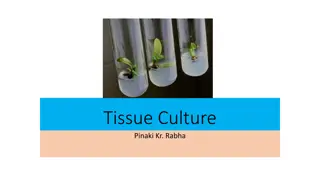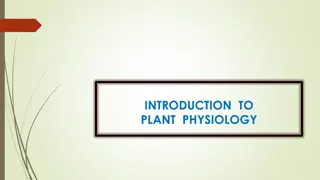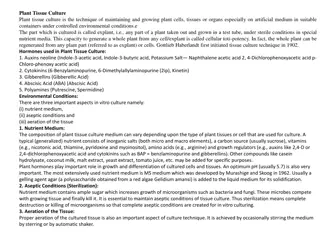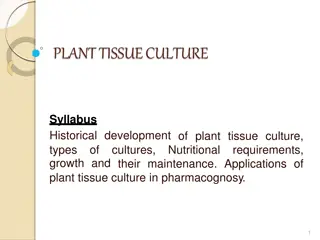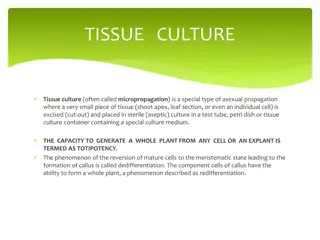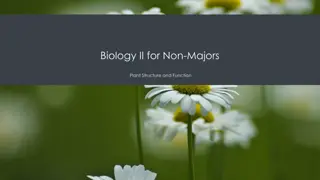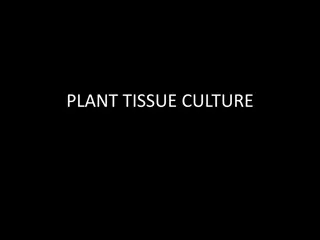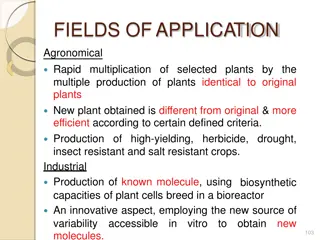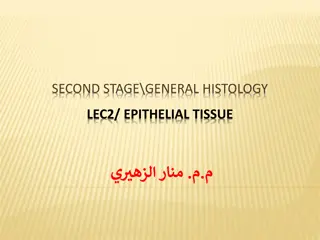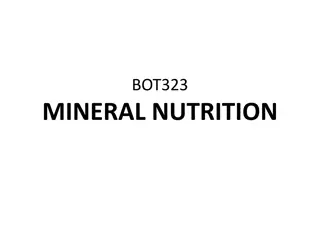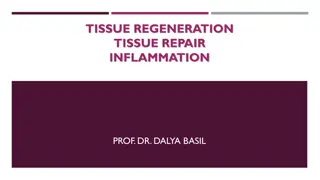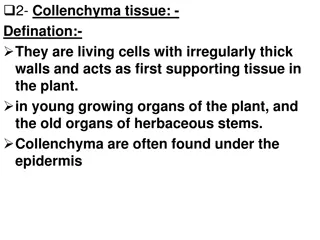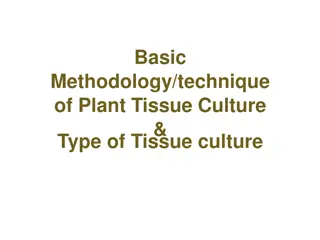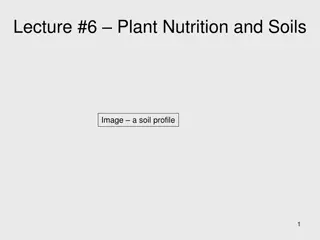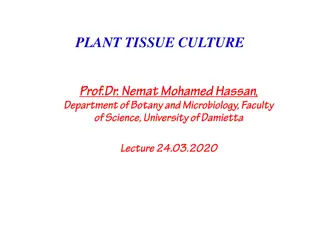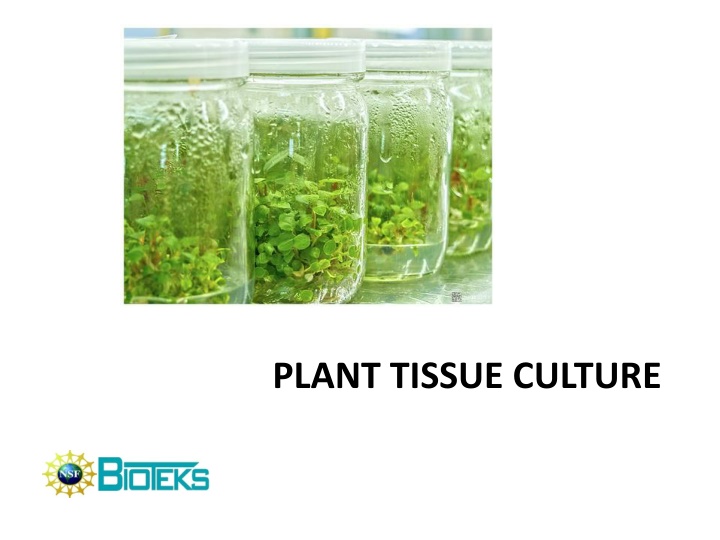
Plant Tissue Culture Techniques
Learn about plant tissue culture, a method for growing plant cells, tissues, organs, and seeds in a sterile environment on a nutrient medium. Discover why it's used, key terminology, and the basic steps involved in the process.
Download Presentation

Please find below an Image/Link to download the presentation.
The content on the website is provided AS IS for your information and personal use only. It may not be sold, licensed, or shared on other websites without obtaining consent from the author. If you encounter any issues during the download, it is possible that the publisher has removed the file from their server.
You are allowed to download the files provided on this website for personal or commercial use, subject to the condition that they are used lawfully. All files are the property of their respective owners.
The content on the website is provided AS IS for your information and personal use only. It may not be sold, licensed, or shared on other websites without obtaining consent from the author.
E N D
Presentation Transcript
What is plant tissue culture? Plant tissue culture is a technique of growing plant cells, tissues, organs, seeds or other plant parts in a sterile environment on a nutrient medium
WHY? The production of clones of plants that produce particularly good flowers, fruits, or have other desirable traits. To quickly produce mature plants. The production of multiples of plants in the absence of seeds or necessary pollinators to produce seeds. The regeneration of whole plants from plant cells that have been genetically modified.
WHY? The production of plants in sterile containers reduces disease transmission Allows production of plants from seeds that otherwise have very low chances of germinating and growing, i.e.: orchids and Nepenthes. To clean particular plants of viral and other infections and to quickly multiply these plants as 'cleaned stock' for horticulture and agriculture.
Terminology Explant Living tissue transferred from a plant to an artificial medium for culture. It can be any portion of the shoot, leaves, roots, flower or cells from a plant.
How? Adult plant cells are totipotent, meaning they have the ability to give rise to a fully differentiated plant. Because of this, it is possible to collect cells from a mature plant and use those cells to produce clones of that plant.
Plant tissue Culture Basics Modern plant tissue culture is performed under aseptic conditions Living plant materials from the environment are naturally contaminated on their surfaces (and sometimes interiors) with microorganisms, so surface sterilization of starting material (explants) in chemical solutions (usually alcohol and sodium or calcium hypochlorite is required).
Plant tissue Culture Basics Explants are then usually placed on the surface of a solid culture medium, but are sometimes placed directly into a liquid medium, when cell suspension cultures are desired. Culture media are generally composed of inorganic salts plus a few organic nutrients, vitamins and plant hormones.
Salt Mixtures Organic Substances Natural Complexes Inert Supportive Materials Growth Regulators
Macro-nutrient salts What the ? NH4NO3 KNO3 CaCl2 -2 H2O MgSO4 -7 H2O KH2PO4 Ammonium nitrate Potassium nitrate Calcium chloride (Anhydrous) Magnesium sulfide (Epsom Salts) Potassium hypophosphate Fe/Na ethylene-diamine-tetraacetate Boric Acid Manganese sulfate Zinc sulfate Potassium iodide Sodium molybdate Cupric sulfate Cobaltous sulfide FeNaEDTA H3BO3 MnSO4 - 4 H2O ZnSO4 - 7 H2O KI Na2MoO4 - 2 H2O CuSO4 - 5 H2O CoCl2 - H2O
Macronutrient salts Nitrogen Influences plant growth rate, essential in plant nucleic acids (DNA), proteins, chlorophyll, amino acids, and hormones. Phosphorus Abundant in meristematic and fast growing tissue, essential in photosynthesis, respiration. Potassium Necessary for cell division, meristematic tissue, helps in the pathways for carbohydrate, protein and chlorophyll synthesis.
Macronutrient salts Calcium - Involved in formation of cell walls and root and leaf development. Participates in translocation of sugars, amino acids, and ties up oxalic acid (toxin). Iron- Involved in respiration , chlorophyll synthesis and photosynthesis. FeNaEDTA = sodium salt ofEDTA sequesters iron, making it available to plants. Magnesium - Involved in photosynthetic and respiration systems. Active in uptake of phosphate and translocation of phosphate and starches.
Micronutrient salts Sulfur - Involved in formation of nodules and chlorophyll synthesis, structural component of amino acids and enzymes. Manganese - Involved in regulation of enzymes and growth hormones. Assists in photosynthesis and respiration.
Micronutrient salts Molybdenum - Involved in enzymatic reduction of nitrates to ammonia. Assists in conversion of inorganic phosphate to organic form. Zinc - Involved in production of growth hormones and chlorophyll. Active in respiration and carbohydrate synthesis. Boron - Involved in production of growth hormones and chlorophyll. Active in respiration and carbohydrate synthesis. Copper -Involved in photosynthetic and respiration systems. Assists chlorophyll synthesis and used as reaction catalyst.
Organic Compounds Carbon Sources Sucrose, sometimes Glucose or Fructose (Plants Need Carbon) Vitamins Adenine part of RNA and DNA Inositol part of the B complex, in phosphate form is part of cell membranes, organelles and is not essential to growth but beneficial Thiamine essential as a coenzyme in the citric acid cycle.
Still other organics Organic Acids Citric acid (150 mg/l) typically used with ascorbic acid (100 mg/l) as an antioxidant. Can also use some of Kreb Cycle acids Phenolic compounds Phloroglucinol - Stimulates rooting of shoot sections
Natural Complexes Coconut endosperm Fish emulsion Protein hydrolysates Tomato juice Yeast extracts Malt extract Potato agar
Growth regulators auxin - Roots cytokinin - Shoots gibberellin Cell Enlargement abscisic acid Plant stress hormone ethylene BAD!
Auxins Callus formation, rooting of cuttings, and the induction of adventive embryogenesis IAA IBA NAA 2,4-D 2,4,5-T Picloram
Cytokinins -Enhances adventitious shoot formation BA 2iP Kinetin Zeatin
Gibberellin Not generally used in tissue culture Tends to suppress root formation and adventitious embryo formation
Abscisic Acid Primarily a growth inhibitor but enables more normal development of embryos, both zygotic and adventitious
Ethylene Question is not how much to add but how to get rid of it in-vitro Natural substance produced by tissue cultures at fairly high levels especially when cells are under stress Enhances senescense Supresses embryogenesis and development in general
Hormone Combinations Callus development Adventitious embryogenesis Rooting of shoot cuttings Adventitious shoot and root formation
Applications[edit] Plant tissue culture is used widely in the plant sciences, forestry, and in horticulture. Applications include: The commercial production of plants used as potting, landscape, and florist subjects, which uses meristem and shoot culture to produce large numbers of identical individuals. 1.To conserve rare or endangered plant species.[6] 2.A plant breeder may use tissue culture to screen cells rather than plants for advantageous characters, e.g. herbicide resistance/tolerance. 3.Large-scale growth of plant cells in liquid culture in bioreactors for production of valuable compounds, like plant-derived secondary metabolites and recombinant proteins used as biopharmaceuticals.[7] 4.To cross distantly related species by protoplast fusion and regeneration of the novel hybrid. ]
5.To rapidly study the molecular basis for physiological, biochemical, and reproductive mechanisms in plants, for example in vitro selection for stress tolerant plants.[8] 6.To cross-pollinate distantly related species and then tissue culture the resulting embryo which would otherwise normally die (Embryo Rescue). 7.For chromosome doubling and induction of polyploidy,[9]for example doubled haploids, tetraploids, and other forms of polyploids. This is usually achieved by application of antimitotic agents such as colchicine or oryzalin. 8.As a tissue for transformation, followed by either short-term testing of genetic constructs or regeneration of transgenic plants. 9.Certain techniques such as meristem tip culture can be used to produce clean plant material from virused stock, such as sugarcane[10], potatoes and many species of soft fruit. Production of identical sterile hybrid species can be obtained. 10.Large scale production of artificial seeds through somatic embryogenesis[11



